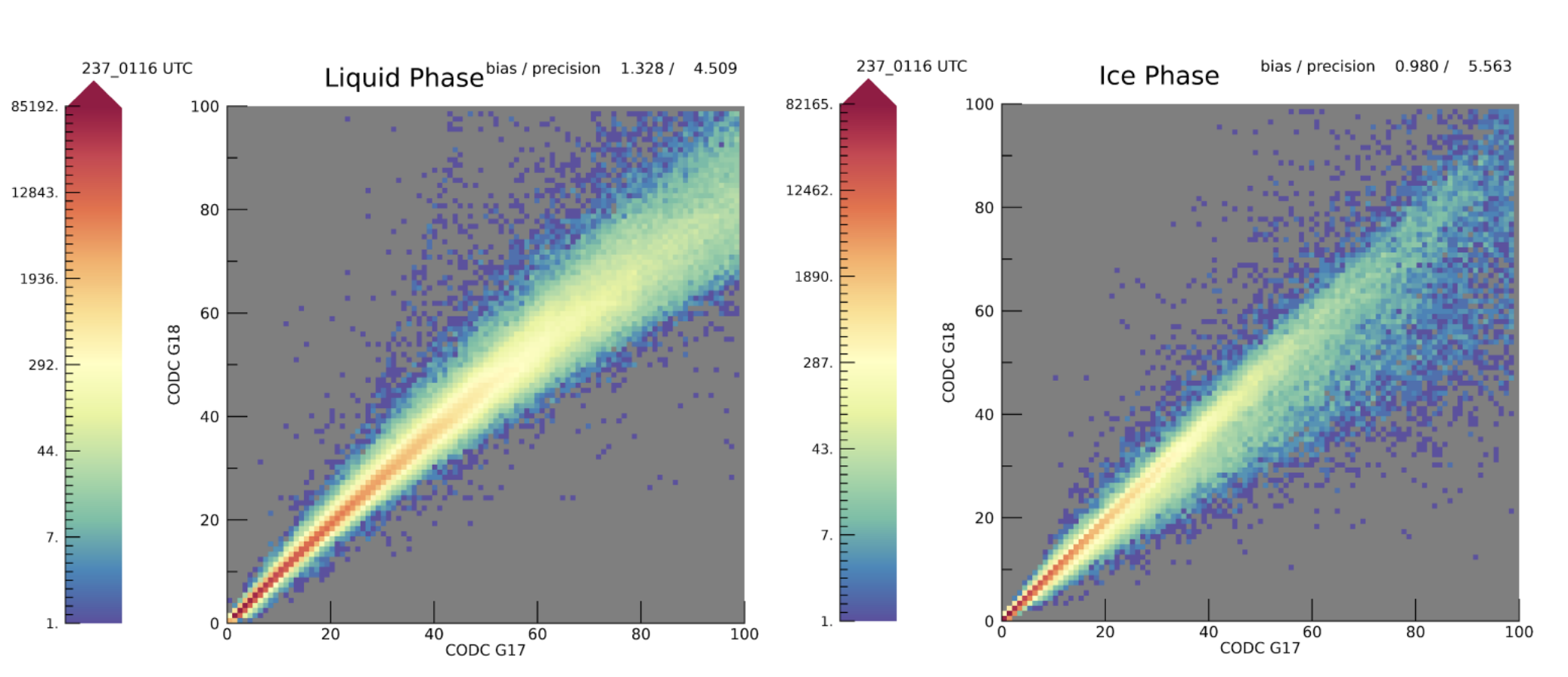
[ Archive ]

 |
CIMSS-NOAA Weekly Report [ Archive ] |
 |
CIMSS AND ASPB WEEKLY HIGHLIGHTS FOR THE WEEK ENDING NOVEMBER 25, 2022
DATA, INFORMATION, AND USE-INSPIRED SCIENCE:
GOES-18 Cloud Optical and Microphysical Properties Product Operational Review: A GOES-18 Advanced Baseline Imager (ABI) Provisional Validation Peer/Stakeholder Product Validation Review (PS-PVR) was held on Monday, November 21 for the Daytime and Nighttime Cloud Optical and Microphysical Properties (DCOMP and NCOMP) products. The primary PS-PVR objective is to assess the state of the DCOMP and NCOMP products with respect to official Provisional Validation metrics that have been previously established to classify the products as operationally ready. Comparisons between collocated GOES-18 and GOES-17 DCOMP/NCOMP cloud optical depth and cloud particle size retrievals were used as the main evaluation datasets, with further comparisons to MODIS cloud products and microwave-based liquid water path retrievals. The GOES-18 DCOMP/NCOMP review panel declared that both products satisfactorily passed the Provisional Review. The DCOMP and NCOMP teams will submit updated presentation slides and documentation based on review panel feedback in early December. (M. Kulie, E/RA2, 608-263-6583, mark.kulie@noaa.gov)
 (Click image to enlarge)
(Click image to enlarge)
Figure: GOES-18 (G18) versus GOES-17 (G17) CONUS Cloud Optical Depth (CODC) comparisons for liquid (left) and ice (right) phase clouds. Bias and precision values are shown in the upper right portion of each figure. These statistical values fell within previously defined Provisional Validation specifications and were one piece of information used to declare the GOES-18 Cloud Optical and Microphysical Properties products as operationally ready. A more exhaustive Full Maturity review will be completed at a later date.
FUTURE OUTLOOK:
AWARDS AND RECOGNITION:
TRAVEL AND MEETINGS:
CIMSS presentation at 12th AOMSUC: Paul Menzel from the Cooperative Institute for Meteorological Satellite Studies (CIMSS) gave an oral presentation at the 12th Asia-Oceania Meteorological Satellite Users' Conference (AOMSUC-12) held 15-17 November 2022 in Tokyo Japan. The presentation “Monitoring Volcanic Emissions with a GEO-LEO Fusion Approach” described spatial-temporal delineation of the Cumbre Vieja volcano emissions on La Palma in the Canary Islands through the fusion of data from Cross track Infrared Sounder (CrIS) or TROPOspheric Monitoring Instrument (TROPOMI) with Advanced Baseline Imager (ABI). Sounder low resolution depiction of volcanic sulfur dioxide are transferred to imager high spatial and temporal resolution. CrIS enables night time coverage complementing TROPOMI day time determinations; ABI adds a monitoring capability with ten minute refresh. The presentation and Q&A with conference participants was accomplished remotely. (W. P. Menzel, CIMSS, 608-263-4930)
TRAINING AND EDUCATION:
UW AOS Lectures on Hyperspectral IR Sounding: P. Menzel and E. Weisz gave back-to-back lectures in the University of Wisconsin-Madison Atmospheric and Oceanic Sciences (AOS) Department's course Weather Satellite Applications (AOS-745). The first lecture was titled “A perspective on the history of satellite observations – from Uncalibrated Flying Objects (UFOs) to Finely Tuned Sensors (FTSs).” It covered the impact on Numerical Weather Prediction of better calibration, improving radiative transfer models, and making spectrally resolved hyperspectral infrared measurements. The second lecture was titled “Hyperspectral Sounder Measurements and Retrievals” and explained the information content in high spectral resolution measurements and ways to solve the inverse problem to retrieve temperature and moisture profiles. (E. Weisz, SSEC/CIMSS, 608-265-3954)
UW AOS Lecture on Cloud Detection in the Polar Regions: Yinghui Liu gave a lecture in the University of Wisconsin-Madison Atmospheric and Oceanic Sciences (AOS) Department's course Weather Satellite Applications (AOS-745). The title was "applications of CloudSat/CALIPSO in studying the Arctic cloud, their cloud detection limitations". Improvements of cloud detections in the polar regions using MODIS, and low-level cloud detection limitation of CloudSat/CALIPSO and its impacts on the radiation fluxes at the surface and the top of atmosphere were presented. (Y. Liu, E/RA2, 608-890-1893, yinghui.liu@noaa.gov)
MEDIA INTERACTIONS AND REQUESTS:
SOCIAL MEDIA AND BLOG Posts:
PUBLICATIONS:
OTHER:
| Archived Weeklies Page | Submit a report item |